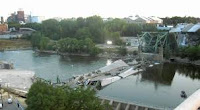Leave Means Leave campaigners like to say that "trading on WTO terms" is a "bridge" from EU membership to an EU free trade deal.
Not true. But this helps paint a picture of exactly what Brexit really means.
The WTO was set up in 1995 as a way for all countries to agree ways to trade more freely with each other ("trade deals") and some very basic rules for fair trade if they cannot agree a trade deal ("WTO terms").
So think of "WTO terms" as the chasm or valley between two countries who want to trade with each other.
It's a long way down, because those are the best/worst trading terms that all countries say should apply where there is no other deal agreed.
In other words, to improve on WTO terms, you need a "trade deal" between countries - like membership of the same regional or other type of free trade bloc (like the EU, for example) - or a "free" trade agreement between the trade bloc and a non-member country (like EU-Canada).
The free trade agreement or treaty (such as EU membership) is the bridge, and WTO terms is the chasm that the countries are trying to get their goods and services across.
Right now, the UK's goods and services are trundling to and from the EU across the WTO chasm via the bridge of EU membership. And a wise government would not remove the bridge of EU membership without building an alternative bridge over the WTO chasm.
It takes 5 to 10 years to build a bridge over the WTO chasm. But after nearly 3 years of negotiation, Theresa May only managed to get until the end of 2020 - not long enough to build a new bridge, even if she had any real idea how to build it.
So, May's deal and No Deal both involve the UK not so much "driving off a cliff" but "falling into the WTO chasm" as the bridge of EU membership collapses.
The only way to avoid this is to revoke (withdraw) the Article 50 notice before it expires on 29 March and try to leave again later (if anyone can figure out how to do that safely).



No comments:
Post a Comment